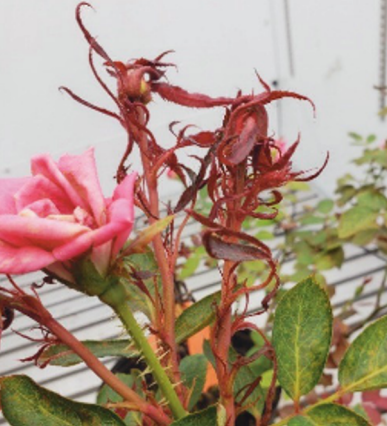Phyllocoptes fructiphilus
Authors: Alejandra Monterrosa, Shimat Joseph, Will Hudson, Jean Williams-Woodward, Bodie Pennisi, University of Georgia, 2020
Description
Immature stages: Larvae are transparent becoming white and slightly translucent as they develop through twolarval stages.
Adult stages: Yellowish in color, adults measure about 140 to 170 micrometers long, tapered at both ends. Adults have two pairs of legs, whereas non-eriophyid mites have four pairs. They have a sub-triangular shield that tapers out to a point approaching the anterior end on the mite’s ventral side, distinct from other species.
Biology
Eriophyid mites reach adulthood about one week after hatching from eggs. They are haplodiploid, developing from either fertilized or unfertilized eggs. Males release spermatophores which females pick up through a genital opening. Females selectively fertilize eggs. Fertilized eggs become female and non-fertilized become male. Adult females lay one egg/day for a few days. Total lifespan is about 11-12 days. Populations build from midsummer into September or October. During fall months mites look for areas within plant to overwinter such as the ovary of rose fruit. Eriophyid mites use wind for dispersal, standing straight up on their tail end, perpendicular to the plant to catch air currents.
Damage
RRD vectored by eriophyid mites can cause major problems for nurseries, landscapers, and gardeners alike. The spread of this mite and virus can cause serious damage to plants, decreasing profits for nurseries and landscapers. The virus causes the plants to become undesirable and will eventually result in the death of the plant, which affects all segments of the rose industry as well as rosarians and home gardeners. RRD is caused by the rose rosette virus (Emaravirus) that affects multiflora and ornamental roses. This virus is causing devastation to roses in several regions of North America, but it is particularly problematic in the eastern half of the continent. It has been estimated that about 93% of rose plants that are susceptible to this disease have the potential to be killed in a matter of decades.
The symptoms of disease on ornamental roses are a yellow mosaic pattern appearing on leaves, increased thorniness, abnormally shaped foliage and early production of lateral buds that make up the witches’ broom (Figures 2 and 3). The symptoms differ slightly in multiflora roses. These roses still get witches broom and misshapen foliage. Unlike the ornamentals, they get a reddish-purple vein mosaic pattern on their leaves and produce bright-red foliage and lateral shoots. The disease eventually results in death of the infected plant.
Management
Eriophyid mites infected with the virus transmit the virus through feeding. Once plants are infected with the virus, they cannot be treated or cured. Disease management relies on early detection and cultural control. Infected plants should be identified early, removed immediately, and replaced. If a rose is planted, then neighboring plants next to the roses need to be plants that are not affected by the virus (non-host plants of P. fructiphilus). This will slow the spread of the mites from plant to plant in that general area. It is important to note that eriophyid mites are dispersed by wind, so plants that appear healthy and were planted near the diseased plants may have the virus but may not yet be showing symptoms. The interval between infection and symptom development is unknown.
Miticides are not recommended for eriophyid mite control because the effectiveness of potential miticides is still not proven. The miticides registered for spider mites may not control this eriophyid mite. Lack of miticide efficacy could be related to their small size and feeding habit as they feed and develop in concealed areas of rose flower bud, such as sepals, which can pose serious challenges without adequate exposure.


